








A Visit to Baalbek and Anjar
April 11th, 2006 - Post No. 51
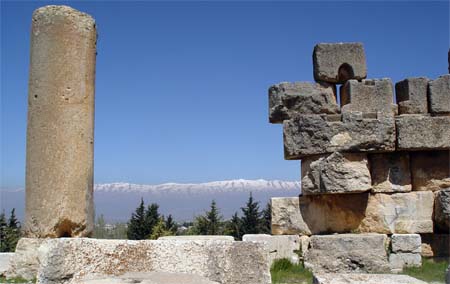
Early on Tuesday morning, April
11th, I join Bishop Nareg and a group of Armenian
writers who have stayed on in Lebanon to do some sight
seeing following
the weekend's conference. Our destination today is
Lebanon's fertile Bekka Valley to visit the famous Roman
ruins in the town of Baalbek and the nearby Armenian
village of Anjar. Beirut rush hour traffic is hard to
negotiate, and it takes all of an hour just to get
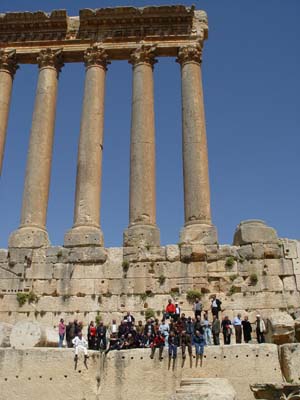 across
the city to the Damascus highway. From there a two hour
drive and we arrive at Baalbek, its ruins (pictured top)
with Sanine and the other coastal mountains looking on
from afar.
across
the city to the Damascus highway. From there a two hour
drive and we arrive at Baalbek, its ruins (pictured top)
with Sanine and the other coastal mountains looking on
from afar.
The company for the trip is more than congenial. Most of the writers in the group are from Armenia and are taking advantage of the days before the one weekly scheduled flight and their return to Yerevan, the Armenian capital, on Thursday.
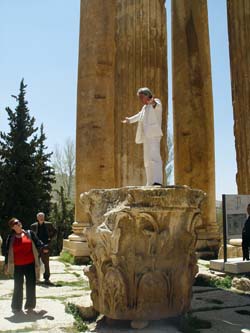
There are more than a few characters, as might be expected, in this group of writers, humourists and poets! Here, Georgian Armenian (no, not from Atlanta) Jhora Snkhchian delivers impromptu a bit of poetry from a very distinguished platform and will later serenade the assembly at a banquet in Anjar, with a couple of Armenian folk songs. He has a strong voice, and his colleagues appreciated his efforts very much.
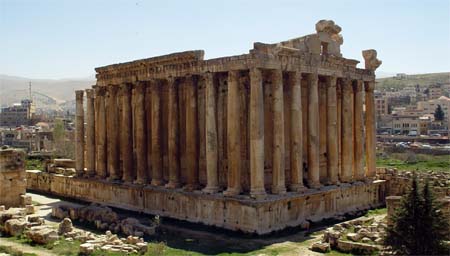
The group photo of the writers, above, is taken before the remains of the great Jupiter temple, but the "smaller temple" to Bacchus, pictured here, is in much better repair.
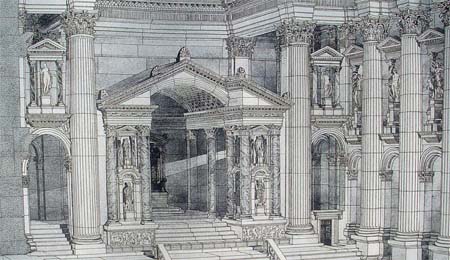
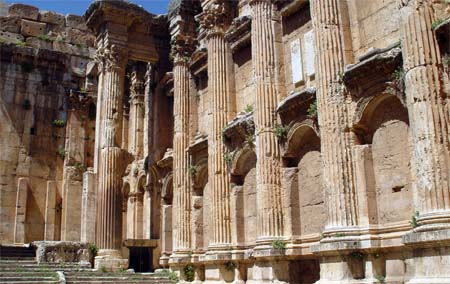
The scale of the temple is probably similar to the long since destroyed structures that would have, in turn, graced the top of Temple Mount in Jerusalem. One of the remaining walls to the Jupiter temple is in fact quite like the Wailing Wall, both vestiges of former glory.
I'm not the only one to find the
temple worth noting. Several visitors in the past have
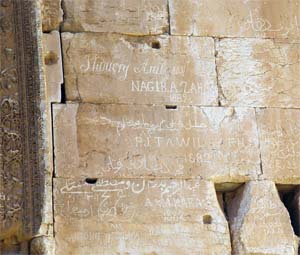 "left
their mark" with signatures here dating back to the
1800s when the ruins were unearthed for all to see for
the first time since antiquity. Today there is a steady
flow of tourists to the ruins of Baalbek, and this is
possibily Lebanon's best known tourist site. In the
course of the morning I hear tour guides lecturing
groups in English, French, German, Arabic, Russian and,
of course, Armenian ... and yet the staff here report
that it is a quiet day!
"left
their mark" with signatures here dating back to the
1800s when the ruins were unearthed for all to see for
the first time since antiquity. Today there is a steady
flow of tourists to the ruins of Baalbek, and this is
possibily Lebanon's best known tourist site. In the
course of the morning I hear tour guides lecturing
groups in English, French, German, Arabic, Russian and,
of course, Armenian ... and yet the staff here report
that it is a quiet day!

Here a security guard and the
keeper of the temple museum pause on the steps of the
"smaller temple" between waves of tourist groups
visiting the ruins. There is 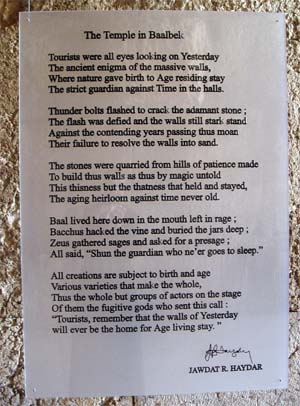 a larger museum near the
exit of the site,
filled with statuary found among the ruins, and a
timeline tracing the several thousand years of the
site's history. Once a temple to the Canaanite god Ba'al
(hence the name, Baalbek), most of the ruins visible
today, date back to the first century of the common era
(a.d.). There were modifications later in the Byzantine
period (part of the Jupiter temple was converted into a
Christian basilica) and more in the reorganisation of
the site following the arrival of Islam in the region.
a larger museum near the
exit of the site,
filled with statuary found among the ruins, and a
timeline tracing the several thousand years of the
site's history. Once a temple to the Canaanite god Ba'al
(hence the name, Baalbek), most of the ruins visible
today, date back to the first century of the common era
(a.d.). There were modifications later in the Byzantine
period (part of the Jupiter temple was converted into a
Christian basilica) and more in the reorganisation of
the site following the arrival of Islam in the region.
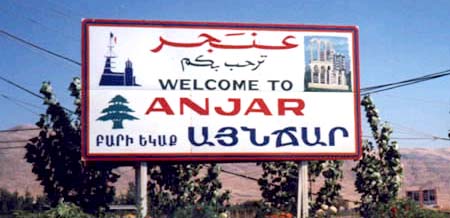
From Baalbek, our buses make the 40 minute drive to the Armenian village of Anjar to the south and east, toward the Syrian border. Made famous by Franz Werfel in his semi-historical novel The Forty Days of Musa Dagh (1934), the inhabitants of Anjar were originally inhabitants of six villages located on the foothills of Mount Moussa, settled here by the French in 1939.
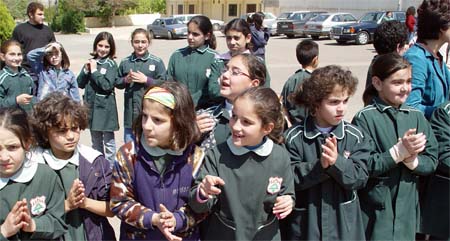
The village founded by the original 1069 families from Mount Moussa has grown into a thriving argriculture and tourist centre. Today Anjar is about 95% Armenian, with strong schools and community institutions. Today's visit by the group of Armenian writers is a major event in the life of the community, the students of the village join many of the community's adults to honour their favourite authors.
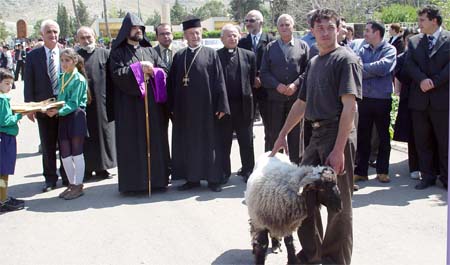
His Grace Kegham Khatcherian , Primate of Lebanon, is on hand (centre) and beside him stand the leaders of the village's three churches: (from left to right) the pastor of the Armenian Evangelical Church (wearing suit and tie), the Armenian Orthodox parish priest, and the pastor of the Armenian Catholic congregation.
The welcome extended to the distinguished visitors is "traditional" meaning that the sheep pictured here is not the village mascot, but (symbolically) a contribution to the feast.
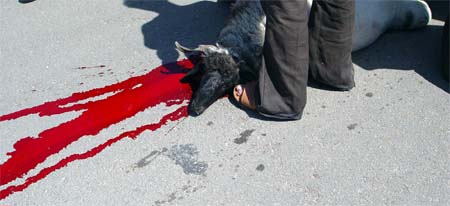
Amid applause and Armenian folk
music, the sheep is slaughtered as a gesture of
hospitality, and members from local scout troups offer
the traditional bread and salt to the visitors, a sign
that they are considered part of the family.
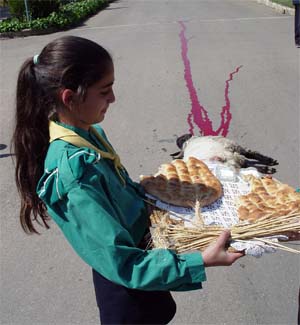 The
ceremonial welcome is followed by a visit to the tall
stone monument dedicated to the memory of the 18
Martyrs of Musa Dagh (who were killed in the Armenian
uprising against the Turks at the beginning of the
genocide) and a round of speeches with the introduction
of all of the authors in the group of visiting writers.
It is clear from the applause that many of the names are
recognized and that their presence in Anjar most
appreciated.
The
ceremonial welcome is followed by a visit to the tall
stone monument dedicated to the memory of the 18
Martyrs of Musa Dagh (who were killed in the Armenian
uprising against the Turks at the beginning of the
genocide) and a round of speeches with the introduction
of all of the authors in the group of visiting writers.
It is clear from the applause that many of the names are
recognized and that their presence in Anjar most
appreciated.
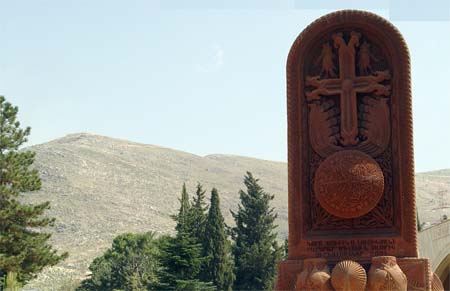
The geographical setting here is as splendid as the weather, and I am reminded of the foothills of my native Northern California. In fact the geography of Lebanon has much in common with California, two chains of mountains, one bordering the sea the other the desert, with a large fertile valley separating the two.
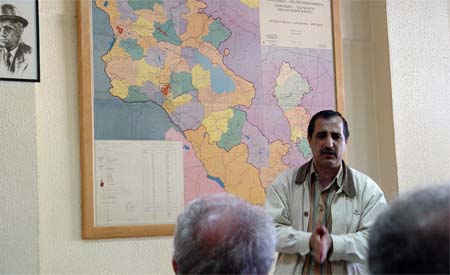
We then move on to City Hall for coffee and a brief presentation reviewing Anjar's history. Pictured here a map of the Turkish homelands of most of the Armenians in Lebanon and Syria.
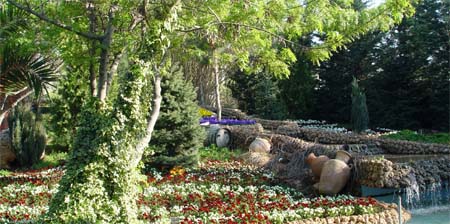
Then it is time to eat, and such a feast! I learn later that Anjar is pretty much the gourmet capital of the Bekka Valley with about 10 restaurants and a reputation for the fine domestic trout raised here.
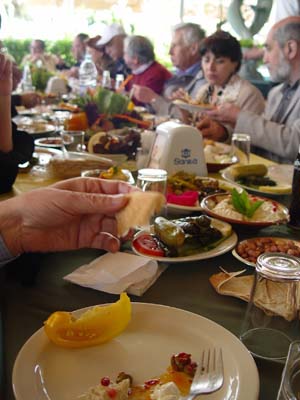 The
restaurant, Anjar's biggest, is a huge octagonal
pavilion with vast covered patios bordering freshly
planted gardens.
The
restaurant, Anjar's biggest, is a huge octagonal
pavilion with vast covered patios bordering freshly
planted gardens.
The food is abundant and delicious, at least a dozen different plates for the mezze -- the standard Middle Eastern first course of side dishes and dips -- including hummus, a kind of beef tartar, garlic eggplant dip, stewed chicken livers, olives and other pickled treats and mounds of fresh vegetables.
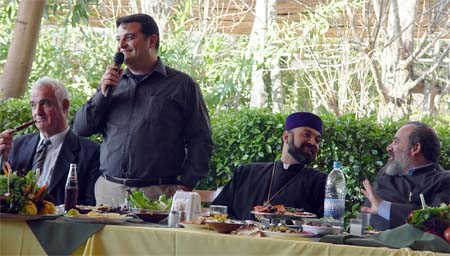
During the main course -- a variety of spicy kebobs -- the writers take turns entertaining the gathered assembly of colleagues and leaders of the local community with stories, songs, witty commentary and more than the occasional recitation of a poem. Here's a sample in this short film (10.6 MB) featuring Dr. Herand Markarian, an Armenian writer from New York, reciting "The Crane" a poem by the Armenian poet, Kevork Emin.
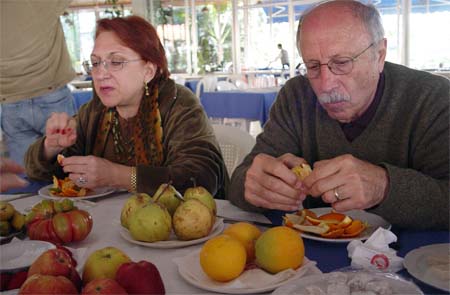
When all of the poems, humour and speeches have ended, we adjourn to an adjoining pavillion for desert. Here we see Dr. Markarian with the writer Vehanoush Tekian (left) enjoying the last course of the banquet, a table of fruit from the Bekka Valley, served with "Armenian Delights" and the ever popular halva.
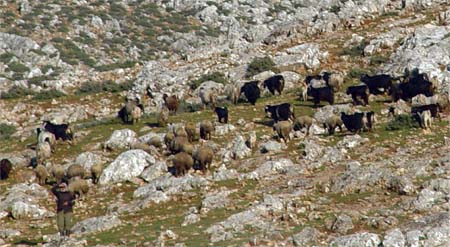
Following supper, we board our buses for a drive through the village of Anjar, passing this flock of sheep and their hurder (lower left) -- possibly the former buddies of the sheep offered up in the "traditional greeting" this afternoon!
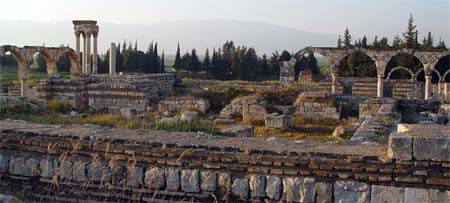
Our destination is the second archaeological park of the day, the ruins of the Byzantine market centre of Umayyad with the columns its once stately palace on the left of the photo above. This is a marvellous way to walk off some of the supper in the warm light of the setting sun.
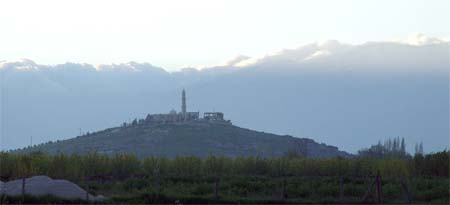
As we board our buses to leave Anjar, I catch this glimpse of a neighbouring mosque. Anjar is unlike the rest of Lebanon in many respects, not only its population is almost entirely Armenian, but it is also clean, well organised and alive with commerce and cultural activity. Perhaps the most reasonable solution for the future of Lebanon would simply be to let the Armenians take over and organise the country!
Tsdesutyun (aurevoir) beautiful Anjar and the Bekka Valley.